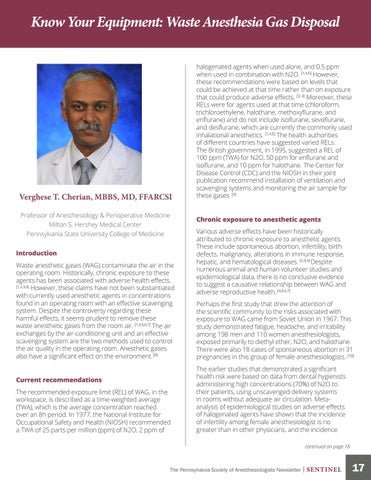Know Your Equipment: Waste Anesthesia Gas Disposal
Verghese T. Cherian, MBBS, MD, FFARCSI Professor of Anesthesiology & Perioperative Medicine Milton S. Hershey Medical Center Pennsylvania State University College of Medicine Introduction Waste anesthetic gases (WAG) contaminate the air in the operating room. Historically, chronic exposure to these agents has been associated with adverse health effects. [1,2,3,4] However, these claims have not been substantiated with currently used anesthetic agents in concentrations found in an operating room with an effective scavenging system. Despite the controversy regarding these harmful effects, it seems prudent to remove these waste anesthetic gases from the room air. [1,4,5,6,7] The air exchanges by the air-conditioning unit and an effective scavenging system are the two methods used to control the air quality in the operating room. Anesthetic gases also have a significant effect on the environment. [8] Current recommendations The recommended exposure limit (REL) of WAG, in the workspace, is described as a time-weighted average (TWA), which is the average concentration reached over an 8h period. In 1977, the National Institute for Occupational Safety and Health (NIOSH) recommended a TWA of 25 parts per million (ppm) of N2O, 2 ppm of
halogenated agents when used alone, and 0.5 ppm when used in combination with N2O. [1,4,6] However, these recommendations were based on levels that could be achieved at that time rather than on exposure that could produce adverse effects. [3, 4] Moreover, these RELs were for agents used at that time (chloroform, trichloroethylene, halothane, methoxyflurane, and enflurane) and do not include isoflurane, sevoflurane, and desflurane, which are currently the commonly used inhalational anesthetics. [1,4,5] The health authorities of different countries have suggested varied RELs. The British government, in 1995, suggested a REL of 100 ppm (TWA) for N2O, 50 ppm for enflurane and isoflurane, and 10 ppm for halothane. The Center for Disease Control (CDC) and the NIOSH in their joint publication recommend installation of ventilation and scavenging systems and monitoring the air sample for these gases. [9] Chronic exposure to anesthetic agents Various adverse effects have been historically attributed to chronic exposure to anesthetic agents. These include spontaneous abortion, infertility, birth defects, malignancy, alterations in immune response, hepatic, and hematological diseases. [2,3,4] Despite numerous animal and human volunteer studies and epidemiological data, there is no conclusive evidence to suggest a causative relationship between WAG and adverse reproductive health. [4,5,6,7] Perhaps the first study that drew the attention of the scientific community to the risks associated with exposure to WAG came from Soviet Union in 1967. This study demonstrated fatigue, headache, and irritability among 198 men and 110 women anesthesiologists, exposed primarily to diethyl ether, N2O, and halothane. There were also 18 cases of spontaneous abortion in 31 pregnancies in this group of female anesthesiologists. [10] The earlier studies that demonstrated a significant health risk were based on data from dental hygienists administering high concentrations (70%) of N2O to their patients, using unscavenged delivery systems in rooms without adequate air circulation. Metaanalysis of epidemiological studies on adverse effects of halogenated agents have shown that the incidence of infertility among female anesthesiologist is no greater than in other physicians, and the incidence continued on page 18
12
The Pennsylvania Society of Anesthesiologists Newsletter |
SENTINEL
17









